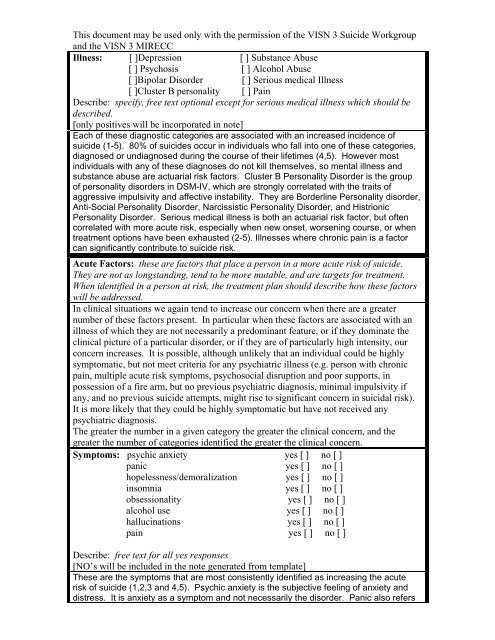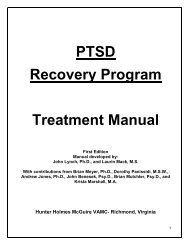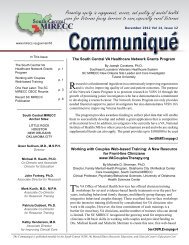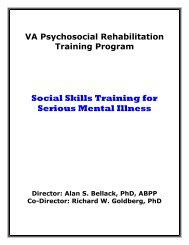Suicide Risk Assessment Package (VISN 3 MIRECC, US ...
Suicide Risk Assessment Package (VISN 3 MIRECC, US ...
Suicide Risk Assessment Package (VISN 3 MIRECC, US ...
Create successful ePaper yourself
Turn your PDF publications into a flip-book with our unique Google optimized e-Paper software.
This document may be used only with the permission of the <strong>VISN</strong> 3 <strong>Suicide</strong> Workgroup<br />
and the <strong>VISN</strong> 3 <strong>MIRECC</strong><br />
Illness: [ ]Depression [ ] Substance Abuse<br />
[ ] Psychosis [ ] Alcohol Abuse<br />
[ ]Bipolar Disorder [ ] Serious medical Illness<br />
[ ]Cluster B personality [ ] Pain<br />
Describe: specify, free text optional except for serious medical illness which should be<br />
described.<br />
[only positives will be incorporated in note]<br />
Each of these diagnostic categories are associated with an increased incidence of<br />
suicide (1-5). 80% of suicides occur in individuals who fall into one of these categories,<br />
diagnosed or undiagnosed during the course of their lifetimes (4,5). However most<br />
individuals with any of these diagnoses do not kill themselves, so mental illness and<br />
substance abuse are actuarial risk factors. Cluster B Personality Disorder is the group<br />
of personality disorders in DSM-IV, which are strongly correlated with the traits of<br />
aggressive impulsivity and affective instability. They are Borderline Personality disorder,<br />
Anti-Social Personality Disorder, Narcissistic Personality Disorder, and Histrionic<br />
Personality Disorder. Serious medical illness is both an actuarial risk factor, but often<br />
correlated with more acute risk, especially when new onset, worsening course, or when<br />
treatment options have been exhausted (2-5). Illnesses where chronic pain is a factor<br />
can significantly contribute to suicide risk.<br />
Acute Factors: these are factors that place a person in a more acute risk of suicide.<br />
They are not as longstanding, tend to be more mutable, and are targets for treatment.<br />
When identified in a person at risk, the treatment plan should describe how these factors<br />
will be addressed.<br />
In clinical situations we again tend to increase our concern when there are a greater<br />
number of these factors present. In particular when these factors are associated with an<br />
illness of which they are not necessarily a predominant feature, or if they dominate the<br />
clinical picture of a particular disorder, or if they are of particularly high intensity, our<br />
concern increases. It is possible, although unlikely that an individual could be highly<br />
symptomatic, but not meet criteria for any psychiatric illness (e.g. person with chronic<br />
pain, multiple acute risk symptoms, psychosocial disruption and poor supports, in<br />
possession of a fire arm, but no previous psychiatric diagnosis, minimal impulsivity if<br />
any, and no previous suicide attempts, might rise to significant concern in suicidal risk).<br />
It is more likely that they could be highly symptomatic but have not received any<br />
psychiatric diagnosis.<br />
The greater the number in a given category the greater the clinical concern, and the<br />
greater the number of categories identified the greater the clinical concern.<br />
Symptoms: psychic anxiety yes [ ] no [ ]<br />
panic yes [ ] no [ ]<br />
hopelessness/demoralization yes [ ] no [ ]<br />
insomnia yes [ ] no [ ]<br />
obsessionality yes [ ] no [ ]<br />
alcohol use yes [ ] no [ ]<br />
hallucinations yes [ ] no [ ]<br />
pain yes [ ] no [ ]<br />
Describe: free text for all yes responses<br />
[NO’s will be included in the note generated from template]<br />
These are the symptoms that are most consistently identified as increasing the acute<br />
risk of suicide (1,2,3 and 4,5). Psychic anxiety is the subjective feeling of anxiety and<br />
distress. It is anxiety as a symptom and not necessarily the disorder. Panic also refers






